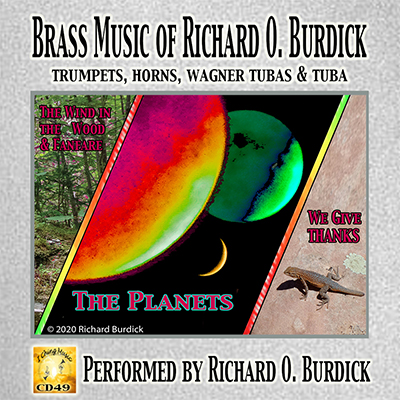
 transform Richard's French horn performance up an octave and brighter for the trumpet parts and an octave lower and warmer for the tuba. Trombone parts were recorded with Mr. Burdick playing Wagner tuba, with an occasionally slide patch in using a real trombone (with a French horn mouthpiece).
transform Richard's French horn performance up an octave and brighter for the trumpet parts and an octave lower and warmer for the tuba. Trombone parts were recorded with Mr. Burdick playing Wagner tuba, with an occasionally slide patch in using a real trombone (with a French horn mouthpiece). About the Composer:
Richard O. Burdick has been a composer since 1976. He works in a diversity of styles.
About the Music:
The Wind in the Woods & Fanfare for Symphonic Brass and Percussion, Op. 192 (2018) This work is a big success being presented by Music in the Mountains (Grass Valley, California) and the Regina Symphony Orchestra during the time of the Covid shutdown.
The Ring Cycle was begun in 1982 and the composer adds a new movement occasionally. This work is a music depiction of the some of the planets, moons and other objects of our solar system There are currently 19 movements.
The Inner Ring:
Sun for Brass Quintet, Op. 9, No. 1 depicts the great power of the Sun. This was completely re-written in the year 2020. The original idea of Mr. Burdick’s use of the I Ching Scale was that scales number one through forty-eight were more representative of daily life and with number forty-nine in order we move to higher realms, such as the planets. With the evolution of Richard’s use of the scales his number ring system uses two numbers the first in the Shau Yung circle order and the second in what is considered the standard order. So in 1982 when he used No. 49 it is now 48-49 known as Advertising in Richard’s interpretation. A switch, or mistake took place and the revision is in scale 49-13 not 48-49, but being that they are next to each other the final key is virtually the same.Mercury for Brass Quintet, Op. 9, No. 2 includes the “cosmic order” melody presented in Richard’s “Planets for solo horn, Op. 19.” This was completely re-written in the year 2020. The composer said: “When I think of Mercury, I think of a hot gaseous planet with bright coloured toxic clouds. I am sure it is just my imagination . . . “
Venus for Brass Quintet, Op. 9, No. 3 (I Ching Scale: v.1 #51) was revise in 2016 from the original 1983 version, and again revised in 2020. It is a soft luminous work.
The Middle Ring:
In 2020 opus 10 was expanded to six movements from its original 1983 version of just four movements. Earth and The Moons of Mars: Phobos and Deimos were added.As the recording and composing of this set progressed in the Early Summer of 2020, Mr. Burdick enjoyed expanding the range of the instruments, so for the Earth (Op. 10 No.1) the Tuba starts very low, setting up a real grounding, then the work is developed in a way reflecting his Op. 19 again.
The Moons of Mars: Phobos and Deimos was written December 26, 2015 this work if not play in an aggressive “Mars” way should be avoided by performers. The other four movements have gone almost unchanged since 1983. (Moon, Mars Choral, Mars and Saturn.)
The Outer Ring was written at the time when the composer was playing at Mills College in Oakland California performing with the Mills Brass Trio. They performed Uranus (Op. 45, No. 1 and Neptune (Op. 45, No. 2) the third movement “Pluto” is marked as written in 1982 and re-written in 2005. This re-right is assumed to be almost a total re-write. Pluto is the wanderer planet constantly spiralling with Charon.
In 2020 Mr. Burdick wrote a four- movement composition The Rings of Saturn, Op. 268. The work depicts the cyclical aspect of a planetary rotation and with this work Richard made a conscious effort to expand the range of the brass quintet with both the physical range and he attempted to push the limits of the concept of “Music.” The third movement is written as if one was actually in the Ring seeing all the independent objects that make up the ring. With this movement he may have gone too far into non-musical randomness. But ultimately this work has an organization to it and acceleration too.
The final work created for the “Ring Cycle” is More Outer Ring, Op. 269. From maps it can be seen that the Asteroid belt is in the center of the largest space between planets in our solar system. It is virtually obvious that a planet is missing here and the Asteroid belt is what is left of the planet. This movement uses three I Ching Scales 49, 53, & 54 (of version 5 scales). It is constructed in a similar way to his We Give Thanks, in that it is musical structure that is projected through or modulated to the different keys. It has the randomness needed to depict and group of asteroids, yet it has a subtle musical cohesion.
Haumea is just a small asteroid.
Charon is arranged from Mr. Burdick’s Opus 254 a work which is a companion to Burdick’s Opus 9 “Pluto for Flute, horn, ‘cello and videotape. Opus 9 is not part of this Ring Cycle for Brass.
About His composition We Give Thanks for Brass Octet, Op. 150a the composer writes: "I remember writing this at my cabin in Bear Valley during the Summer of 2007, a very enjoyable time watching mountain birds out of my window." (This was his last year playing for the Bear Valley Music Festival (1992-2007)).
This composition was originally like birdcalls all singing "We Give Thanks" but in many different random times and just sort of cacophonous. Originally this work was in 10/8 with a beat of 2+3+1+3+1, the beat has been kept in the revision, but has been changed to a 5/8 time signature. The work was begun as an I Ching Cycle work in I Ching Scales v.3.
The almost complete revisions in January of 2019 keeps the same set of I Ching scales (2, 21, 23, 17, 8, 25, 20, 42, 12, 3, 45, 27, 35 and 24) This set of 14 scales gives us a huge amount of information. The scales plus one small section from the original (IC 45 measures 1-4 or 161-170 in the original version in 5/8) and the motive "We Give Thanks" is a huge amount of information way more than needed for a musical composition.
With the use of the flow into and through the 14 different scales in somewhat a random way, this work is unique in its flow through tonalities. Unique except for the work “The Asteroid Belt.”About the Recording:
This multi track recording was done in June and July of 2020. Mr. Burdick has been exploring the "plug-in" spectral effects in his recording program. This can transpose the sound up or down an octave (any aything in-between) and the effect can change the brightnes or warmth of the sound. Richard performed the trumpet, horn and tuba parts on his Finke tripple horn, and the trombone on his Wagner tuba. The trumpet and tuba parts were transformed by spectral effects to sound much more like real trumpets and tubas, but with the soul of a real musician performing.
Cover Photo : Forrest scene from Oympic National Part, Moon pictures transformed and lizard from Zion National Park by R Burdick
Videos:
About the Recording:
Richard Burdick as a musician:
French hornist: Richard O. Burdick is the first horn of Regina Symphony Orchestra and the Regina Symphony Chamber Players in Regina, Saskatchewan, Canada. He is a prolific composer.
His move to Canada in 2003, with his wife Rebecca and his two boys, marked the start of the fourth major period in his musical Career.
In the 1980’s Richard was first Horn of Napa Symphony, a member of a San Francisco based theater orchestra and played lots of chamber music as manager of Trinity Chamber Concerts, a chamber music series in Berkeley California.
Starting in 1990 he played fourth Horn full-time for Sacramento Symphony, which went bankrupt in 1996. He then won auditions for Fresno Philharmonic, Napa & North State Symphonies and played in Sacramento Philharmonic & Opera.
He is a prolific composer and has many self produced CD’s of his own compositions, Bach, his classical natural horn playing and multi-track performances of many of his favorite pieces.
He performs on a variety of horns, a baroque natural horn (1720), a classical era natural horn (1800), a romantic era (1840's) natural horn, a single F horn from the 1880's, his main symphony horn is a Brendan Model Finke triple horn.
He has also done many music related jobs such as arranger for Sacramento Symphony, librarian and personal manager for Sacramento Philharmonic, and manager of Trinity Chamber Concerts (chamber music series) in Berkeley, California for 19 years starting in 1984.
![]()
![]()
ISRC
Would you like to comment on this work?We would appreciate comments,
|
|---|
CD49 tracks:
The Wind in the Woods & Fanfare for Symphony Brass and Percussion
1) The Wind in the Woods, Op. 192 No. 1
2) Fanfare, Op. 192 No. 2
THE INNER RING:
3) Sun for Brass Quintet, Op. 9, No. 1
4) Mercury for Brass Quintet, Op. 9, No. 2
5) Venus for Brass Quintet, Op. 9, No. 3
THE MIDDLE RING:
6) Earth for Brass Quintet, Op. 10, No. 1
7) Moon for Brass Quintet, Op. 10, No. 2
8) Mars Choral for solo horn, Op. 10, No. 3
9) Mars for Brass Quartet, Op. 10, No. 4
10) Phobos and Deimos for Brass Quartet, Op. 10, No. 5
11) Saturn for Brass Quintet, Op. 10, No. 6
THE OUTER RING:
12) Uranus for Brass Trio, Op. 45, No. 1
13) Neptune for Brass Trio, Op. 45, No. 2
14) Pluto for Brass Trio, Op. 45, No. 3
THE RINGS OF SATURN
15) Ring of Saturn I for Brass Quintet, Op. 268, No. 1
16) Ring of Saturn II for Brass Quintet, Op. 268, No. 2
17) Ring of Saturn III for Brass Quintet, Op. 268, No. 3
18) Ring of Saturn IV for Brass Quintet, Op. 268, No. 4
MORE OUTER RING:
19) Asteroid Belt for Brass Octet, Op. 269, No. 1
20) Haumea for Brass Quintet, Op. 269, No. 2
21) Charon for Brass Octet, Op. 269, No. 3
22) We Give Thanks for Brass Octet, Op. 150a

UPC-12-728488426050